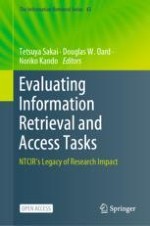6.1 Introduction
6.2 NTCIR MOAT
6.2.1 Overview
NTCIR-6 | NTCIR-7 | NTCIR-8 | |
|---|---|---|---|
Target | English, Japanese, Traditional Chinese | ||
Language | – | \(+\)Simplified Chinese | |
Subtasks | Opinionated, Relevance, Polarity, Holder | \(+\)Target | \(+\)Cross-lingual |
Annotation Unit | Sentence | Opinion Clause | |
Focused Application | Information Retrieval | Q&A (ACLIAa) | Opinion Q&A |
Target Corpora | Mainichi, Yomiuri, CIRB, Xinhua English, Hong Kong Standard, etc. | \(+\)Xinhua Chinese | \(+\)NYT, UDN |
(Period) | 1998–2001 | 2002–2005 | |
6.2.2 Research Questions at NTCIR MOAT
6.2.3 Subtasks
6.2.4 Opinion Corpus Annotation Requirements
English (F1-score)/\(\kappa =0.73\) | |||||||||
|---|---|---|---|---|---|---|---|---|---|
Rank on agreed | Significance | Rank on non-agreed | |||||||
UNINE-1 | A | UNINE-1 | |||||||
NECLC-bsf | A | B | NECLC-bs1 | ||||||
NECLC-bs0 | A | B | C | NECLC-bsf | |||||
NECLC-bs1 | A | B | C | D | NECLC-bs0 | ||||
UNINE-2 | B | C | D | UNINE-2 | |||||
KLELAB-3 | B | C | D | E | NTU-2 | ||||
KAISTIRNLP-2 | C | D | E | KLELAB-2 | |||||
KLELAB-2 | C | D | E | KLELAB-3 | |||||
KAISTIRNLP-1 | C | D | E | NTU-1 | |||||
NTU-2 | D | E | F | KLELAB-1 | |||||
KLELAB-1 | D | E | F | KAISTIRNLP-2 | |||||
NTU-1 | D | E | F | KAISTIRNLP-1 | |||||
OPAL-2 | E | F | G | OPAL-1 | |||||
OPAL-3 | F | G | OPAL-2 | ||||||
OPAL-1 | F | G | OPAL-3 | ||||||
PolyU-1 | G | SICS-1 | |||||||
SICS-1 | G | H | PolyU-1 | ||||||
PolyU-2 | H | PolyU-2 | |||||||
Traditional Chinese (F1-score)/\(\kappa =0.46\) | |||||
|---|---|---|---|---|---|
Rank on agreed | Significance | Rank on non-agreed | |||
CityUHK-2 | A | CityUHK-1 | |||
CTL-1 | A | CityUHK-3 | |||
CityUHK-1 | A | KLELAB-1 | |||
CityUHK-3 | A | NTU-1 | |||
WIA-1 | A | NTU-2 | |||
WIA-2 | A | CityUHK-2 | |||
KLELAB-3 | B | cyut-1 | |||
KLELAB-1 | B | KLELAB-3 | |||
NTU-2 | B | WIA-1 | |||
NTU-1 | B | WIA-2 | |||
cyut-1 | B | cyut-2 | |||
cyut-2 | B | C | CTL-1 | ||
UNINE-1 | C | D | UNINE-1 | ||
cyut-3 | D | cyut-3 | |||
Simplified Chinese (F1-score)/\(\kappa =0.97\) | ||||||
|---|---|---|---|---|---|---|
Rank on agreed | Significance | Rank on non-agreed | ||||
PKUTM-2 | A | PKUTM-2 | ||||
PKUTM-1 | A | B | PKUTM-1 | |||
BUPT-2 | A | B | BUPT-2 | |||
CTL-1 | B | CTL-1 | ||||
PKUTM-3 | B | C | PKUTM-3 | |||
BUPT-1 | B | C | BUPT-1 | |||
WIA-1 | C | D | WIA-1 | |||
WIA-2 | C | D | WIA-2 | |||
NECLC-bsf | D | NECLC-bsf | ||||
NECLC-bs0 | D | NECLC-bs0 | ||||
NECLC-bs1 | D | NECLC-bs1 | ||||
PolyU-1 | E | PolyU-1 | ||||
Japanese (F1-score)/\(\kappa =0.72\) | |||||
|---|---|---|---|---|---|
Rank on agreed | Significance | Rank on non-agreed | |||
TUT-1 | A | TUT-1 | |||
TUT-3 | A | B | TUT-3 | ||
IISR-3 | B | C | IISR-3 | ||
TUT-2 | B | C | TUT-2 | ||
IISR-1 | B | C | IISR-1 | ||
IISR-2 | C | IISR-2 | |||
UNINE-1 | D | UNINE-1 | |||
6.2.5 Cross-Lingual Topic Analysis
English | Traditional Chinese | Simplified Chinese | Japanese | |||||
|---|---|---|---|---|---|---|---|---|
Topic | Opinion % in doc set | Topic | Opinion % in doc set | Topic | Opinion % in doc set | Topic | Opinion % in doc set | |
Easy topics | N27 | 25.4 | N14 | 56.5 | N18 | 24.5 | N41 | 34.6 |
N39 | 21.2 | N05 | 55.6 | N20 | 20.7 | N11 | 35.3 | |
N14 | 21.3 | N27 | 57.6 | N06 | 22.7 | N13 | 28.1 | |
Difficult topics | N18 | 7.6 | N16 | 19.4 | N07 | 9.5 | N24 | 35.3 |
N13 | 8.9 | N13 | 15.0 | N41 | 14.9 | N18 | 37.7 | |
N06 | 10.0 | N20 | 18.8 | N16 | 20.6 | N32 | 27.0 | |
Average | Avg. | 16.7 | Avg. | 32.1 | Avg. | 18.6 | Avg. | 33.9 |
